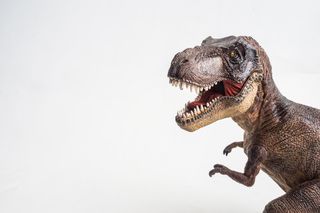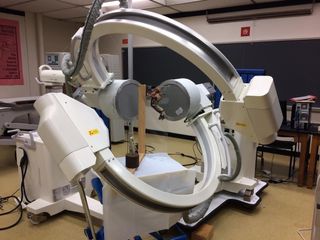Hail the Lizard King. T. Rex's Puny Arms Were Useful After All.
By studying the arm movements of two distant relatives of T. rex — the domestic turkey (Meleagris gallopavo) and the American alligator (Alligator mississippiensis) — researchers have learned that T. rex and other theropods (a group of mostly meat-eating, bipedal dinosaurs) could likely turn the palms of their hands toward their chests.
In essence, "they may have been able to rotate the palm of the hand inward and upward in such a way that the palm would face the chest when the elbow was flexed," study co-researchers Christopher Langel, an undergraduate student of geology, and Matthew Bonnan, a professor of biology, who are both at Stockton University in New Jersey, told Live Science. [Photos: Newfound Dinosaur Had Tiny Arms, Just Like T. Rex]
This adds to the popular saying that "T. rex was a clapper not a slapper," in the way that it held its hands. In other words, the dinosaur likely kept its hands in a clapping position (palms facing inward) rather than a slapping stance (palms facing downward). But the dinosaur king wasn't limited to clapping: the new research suggests T. rex and other theropods could turn their palms inward and upward if they so desired.

As for why this would be advantageous, it's hard to say for certain without seeing a ferocious, nonavian theropod in action, the researchers said. "But we might speculate that such a movement (rotating the forearm and hand in toward the chest) could allow some theropods to bring prey in close for a bite,"Langel and Bonnan told Live Science in an email.
In fact, the next step of the scientists' research may shed light on this question. The team plans to examine the shapes of the forelimb bones in the theropod Allosaurus and compare them with those of alligators and turkeys "to help us narrow down whether this could actually occur in a theropod dinosaur," said Langel and Bonnan. The two presented their research here at the 78th annual Society of Vertebrate Paleontology meeting yesterday (Oct. 17). The research has yet to be published in a peer-reviewed journal.
Turkey time
The researchers couldn't simply study a T. rex arm, because soft joint tissues rarely fossilize. "As a consequence, we are missing information on what the shapes of the [theropod] joints actually looked like and how far apart the bones were when the predatory dinosaur was alive," Langel and Bonnan said.

To investigate, then, the researchers looked at the ulna and humerus in the alligator and turkey with a technique called X-ray Reconstruction of Moving Morphology, or XROMM. First, the investigators attached each wing and arm to a plexiglass platform between two devices that generated X-ray movies. Then, the researchers used fishing wire to tug on the elbow of each specimen, causing the wing and arm to fold up, the researchers said. [Image Gallery: The Life of T. Rex]
Sign up for the Live Science daily newsletter now
Get the world’s most fascinating discoveries delivered straight to your inbox.
Finally, "we used the two X-ray views of each elbow to reconstruct how the bones moved in three dimensions by precisely matching virtual models of each bone to the movies," the researchers said.
The results showed just how complex turkey and alligator elbows are. In humans, "when we flex our elbows, both forearm bones follow the hinge joint to fold in toward the upper arm," the researchers said. "Our hands often rotate palm side up when we flex our elbows, because one forearm bone pivots around the other."
On the other hand (so to speak), in alligators and turkeys, "the elbow joint is more complex, and both bones in the forearm not only pivot around the joint, but [also] rock sideways toward the upper arm bone as the elbow is flexed," the researchers said. "Unlike our elbows, both forearm bones [in alligators and turkeys] cause the palm of the hand to turn inward and somewhat upward."
These results were somewhat unexpected, the scientists said.
"It was especially surprising to see how much the forearm bones could rock side to side at the elbow, a movement that is essentially off limits to mammals like us," Langel and Bonnan said. "In essence, alligators and turkeys can turn the palm of the hand inward and upward like we do, but [they do it] by using more-complex movements of the bones at the elbow. Once again, Mother Nature has solved the same problem in different ways." [Dinosaur Profile: Tyrannosaurus Rex (Infographic)]
Other paleontologists were impressed with the team's approach.
"If we just look at bones without considering cartilaginous reconstructions, we could potentially slip into different results as to how we reconstruct the movement of limb joints," Viktor Radermacher, a master's student of paleontology at the University of the Witwatersrand in Johannesburg, South Africa, who wasn't involved with the research, told Live Science. "And that has very big downstream implications for how we interpret ancestral things that then evolve into more specialized forms and understanding that transition."
Matthew Inabinett, a graduate student of paleontology at East Tennessee State University, who wasn't involved with the research, agreed. "It's easy to forget how much of a part soft tissue and cartilage play" in the movement of creatures that died so long ago, Inabinett told Live Science.
Originally published on Live Science.

Laura is the archaeology and Life's Little Mysteries editor at Live Science. She also reports on general science, including paleontology. Her work has appeared in The New York Times, Scholastic, Popular Science and Spectrum, a site on autism research. She has won multiple awards from the Society of Professional Journalists and the Washington Newspaper Publishers Association for her reporting at a weekly newspaper near Seattle. Laura holds a bachelor's degree in English literature and psychology from Washington University in St. Louis and a master's degree in science writing from NYU.
Most Popular




